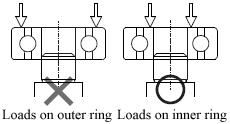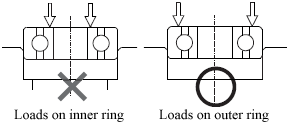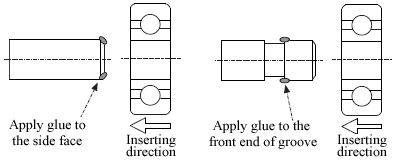Handling of a Bearing
If ball bearings were improperly assembled to either shafts or housings, the bearings could be damaged. This would shorten the life due to noise, vibration, and heat generation. Careful handling is also required during shipping and storing.
1 Notes on storage
Ball bearings undergo noise and visual inspections and delivered in a clean condition.
Care must also be taken to keep the product in a clean state during storage until use.
1-1 Dust must be avoided for bearings
If dust enters the ball bearing, it gets caught between the ball and raceway, increasing noise and decreasing durability.
Dust includes fine fibers, dust, paper, etc. and metal powder.
- Do not open unnecessarily
Open immediately before use. - Repackage unused parts (fractions) after unpacking Unused products should be sealed and not opened.
- Beware of dust during use
Even during use, cover bearings frequently to prevent dust from adhering.
1-2 Bearings easily rust
Many ball bearings use high carbon chromium bearing steel.
One aspect of this material is that it easily rusts.
- Avoid places where there are large changes in temperature and humidity
Store indoors, avoiding places where there are large fluctuations in temperature and humidity, such as those exposed to outside air or direct sunlight. - Do not place the packing box directly on the floor
Avoid placing it directly on the floor (ground, concrete, etc.).
Place the box on a pallet or shelf. - Do not touch with bare hands
Use clean rubber gloves, finger cots, tweezers, etc., and avoid direct contact with bare hands. Care must be taken because skin oils often cause rust.
1-3 Bearings are vulnerable to impact
Ball bearings undergo brinelling when subjected to impact load.
Be especially careful when handling miniature bearings with low load capacity.
- Do not handle in rough manner
Do not drop or throw it from high places even in the packaged state.
Do not handle bearings roughly when moving them to a container to be stored.
Doing so may cause brinelling and denting of shield plate. - Do not use dropped products
Do not use bearings that have been dropped on the floor.
Brineling caused by drop impact may cause abnormal sound.
2 Notes on use and assembling
Improper use and incorporation of ball bearings may cause abnormal noise, vibration, runout and rotational issues. Keep the work environment clean and pay attention to parts and work management.
2-1 Do not process
Be sure to use the bearings as delivered.
- Disassembly and reassembly
Do not disassemble or reassemble the bearings. Abnormal noise and rotation failure may occur due to ingress of dust or scratches.
2-2 Cleanliness
Pay attention to the cleanliness of bearings and mating components.
- Cleaning parts (Figure 19-1)
Clean the parts where the bearing is assembled, such as the shaft and housing.
Foreign matter adhering to the shaft or housing causes abnormal noise or misalignment (failure in assembly precision).

2-3 Wiping off the oil
Before adhering, you may wipe off the rust-preventive oil applied to the outer and inner diameters of the bearing, but this may cause the solvent to penetrate the bearing, which may cause noise and rotation failure.
- Use a clean dust-proof cloth
Consider the frequency of use and keep it clean. - Use minimal solvent
Normally, oil is wiped off with a cloth soaked with a solvent such as alcohol. In such case, be sure to minimize the solvent.
If there is too much solvent, dust may enter the bearings mixed with the solvent, causing abnormal noise.
2-4 Fits
Inappropriate "fitting" causes creep (slip wear), rotation failure (high torque, vibration, heat generation), brinelling, etc.
- Roundness of shaft and housing
Pay attention to the roundness of the shaft and housing. The shape of the shaft and housing is transferred to the raceways of the inner and outer rings, resulting in poor roundness and vibration, abnormal noise and runout.
In particular, care must be taken with miniature bearings as they are easily deformed. - Dimensions of shaft and housing
Make sure that the shaft and housing dimensions are correct.
Excessive press-fitting of the "fit" surface due to dimensional defects may cause rotation problems
(torque, vibration, heat generation), brinelling, etc. - Shaft and housing shapes (precautions on design)
Pay attention to the shape of the shaft and housing. The roundness of the inner and outer rings may be deteriorated due to the discontinuous shape of the shaft outer circumference and the screws provided on the end surface of the housing. - Chamfering of shaft and housing
Pay attention to the size and shape of the chamfer of the shaft and the housing where the bearing end face abuts. If chamfer interferes, it will not be assembled at the correct position, causing misalignment (improper assembly precision). - Burrs and scratches on the shaft and housing
Be sure to check the shaft and housing for burrs and scratches.
If burrs are caught on the surface where the bearing contacts, misalignment (assembly precision failure) may occur, or scratches on the "fitting" surface may deteriorate the roundness of the raceways of the inner and outer rings
2-5 Load/Vibration
Incorrect mounting of the bearing onto the shaft or housing may cause brinelling.
Fretting may also occur due to vibration of the assembly line. If the transfer to the container is performed in a rough manner, the bearings may collide with each other, causing dents in the shield plate.
- Press the inner ring when press-fitting the shaft (Figure 19-2)
When inserting the bearing into the shaft, press the inner ring side surface.
Pressing the outer ring end surface causes brinelling. - Press the outer ring when press-fitting into the housing
(Figure 19-2)
When inserting the bearing into the housing, push the outer ring end surface.
Pressing the inner ring end surface causes brinelling.


Figure 19-2 Load position in press-fitting - Insert straight (Figure 19-3)
Use the proper jigs and insert straight.
Inserting obliquely may cause galling in the shaft and housing, causing misalignment (assembly precision failure) due to entrapment of galling particles and deterioration in roundness due to scratches. - Vibration (vibration of belt conveyors, etc.)
When using a belt conveyor, try to reduce the vibration. Fretting occurs when micro-vibration is applied to non-rotating bearings.

2-6 Adhesive
When using an adhesive to fix the bearing, use care to avoid penetration into the bearing and uneven thickness. Abnormal noise and rotation failure may occur.
In particular, be careful with miniature bearings as it is difficult to work with, and the inner and outer rings are thin and easily deformed.
Make sure you understand and use the type and properties of the adhesive.
- Preventing adhesive penetration (Figure 19-4)
Take measures such as providing a groove for the adhesive reservoir on the shaft and housing.
Also, apply the coating to the shaft end, chamfered part of the bearing, etc. - Managing the application amount
Control the volume with a dispenser etc. to minimize the amount. - Make sure there is no uneven adhesive
Uneven thickness may deteriorate the roundness of the bearings.
Be sure to apply the adhesive evenly.

2-7 Air blowing
Compressed air may be used for dust removal, etc., but depending on how it is sprayed, abnormal noise and rotational issues may occur.
2-8 Applying grease to the housing
Grease may be applied to the housing to reduce noise and vibration, but care must be taken with the used grease.
- Do not use greases with different properties
Performance may be affected by mixing greases with different properties with the grease sealed in the bearing. - Use a clean grease
If contaminated grease is used, foreign matter will enter the bearing and generate abnormal noise.
2-9 Varnish gas
When impregnating the motor coil with varnish, varnish gas may be generated due to insufficient drying, which may cause rusting. Abnormal noise may also occur.
2-10 Chemical attack
If the bearing assembly is made of resin, oil may cause chemical attack (resin cracking).
- Checking the resin material
The degree of chemical attack varies depending on the resin material.
Understand the properties of the materials. - Checking the fit tolerance
If the strain amount is large, chemical attack is likely to occur.
Be sure to check the dimensions before use.
2-11 Effect of magnetization
Avoid magnetizing the bearings. Attracts iron-based foreign matter and causes abnormal noise and misalignment (assembly precision failure).
Related page
Engineering Information for Miniature & small ball bearings
Selecting the Right Part
Technical Data
Contact Us
Please click the inquiry type below according to your question. Each product / sales representative will respond to you.